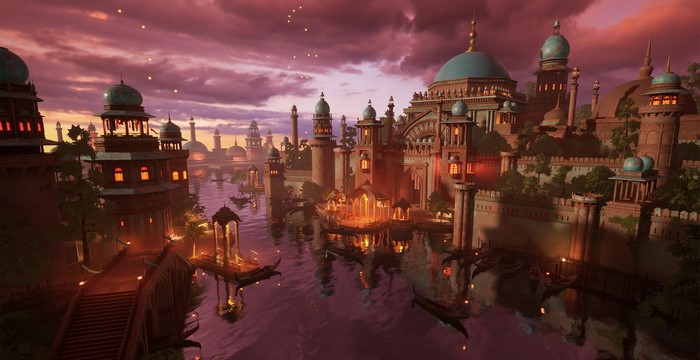Shokuro
Overview
Shokuro is the largest and most stable of the post-imperial Turami nations, established from the riverlands and coastal areas previously administered by the Shou Empire's southern satrapies. Akenari Tenzan, a ronin of mixed Minkai and Turami origin, unified it about three centuries ago, after it had been torn by warlords and religious powers. Following the fall of the empire, Akenari established a new state based on discipline, conquest, and a system of spiritual and military order. The present Shogunate still derives its authority from his family, and his code—Tenzoku, or "The Way of Heavenly Rule"—remains the core of Shokuran government. Shokuro is also known as the River Shogunate because its authority originates in the river cities and ports along Turam's rich eastern coastline. Unlike the turbulent city-states to the west and the nomadic khanates to the north, Shokuro has a unified taxes, legal system, and military leadership. It combines a courtly warrior culture passed down by Minkai with Turami agricultural prosperity, Okanist spiritual traditions, and a governmental model adopted from Shou Lang.Shogunate Governance
Shokuro is ruled by a hereditary military regime known as the Shogunate, descending from conquering warlord Akenari Tenzan who named himself Shōgun no Amanogawa ("General of the Heavenly River"). His family continue to govern from the coastal capital of Barisingdi, a walled city of canals, shrines, and sword schools.The Tenzoku Court
The Shōgun is advised by the Tenzoku Court, composed of:- Hatamoto (chief retainers and daimyōs of the realm)
- Tairō (grand chancellor, the highest civilian official)
- Gokenin (vassal lords and knights of lesser status)
- Sōritsu-sha (high priests from major temples of Okan, Mazdayasna, and others)
The Daimyō System
Shokuro is divided into 28 domains, each ruled by a daimyō, a hereditary noble-lord who oversees both civil and military affairs in his territory. The daimyō are responsible for maintaining peace and order, reporting to the Shōgun and collecting taxes and levies. They command their own retainers (samurai) and enjoy local autonomy, but everyone must take the Tenzoku Oath, which promises loyalty, justice, and the defense of the realm. The daimyō swears a spiritual oath before a shrine based on their faith.Religious Influences in Shokuro
Religion is deeply ingrained in the Shōgunate of Shokuro, despite being a secular regime. Shokuro, rather than operating as a theocracy, follows a sacralized state model in which religious authority and spiritual legitimacy are incorporated into the fabric of rulership. Multiple traditions, particularly Okanism, Mazdayasna, and The Eightfold Path, interact and compete within this structure, with each finding a place in the court, the countryside, and the realm's cultural conscience. In modern times, Okanism has risen as a powerful spiritual and intellectual force in Shokuro. While it lacks a formal political framework, its monasteries, guru-led congregations, and community temples serve as hubs for study, mediation, and ethical leadership throughout eastern and southern Shokuro. However, Okanism is not without debate. Its anti-caste, egalitarian culture occasionally clashes with the hierarchical samurai order, and some orthodox aristocrats are wary of its growing influence—especially its focus on spiritual equality across social classes. The Mazdayasni faith, which honors the holy Truth, cosmic Order (Asha), and the divine flame, predates the Shogunate and has ancient roots among the Turami noble families who previously dominated the region under imperial Shou administration. Mazdayasna, despite being overtaken in common life by Okanism, retains prestige and ceremonial power, especially in the western interior regions. However, problems remain between conservative Mazdayasni factions and Okanist clergy, particularly in mixed cities where proselytization, marriage law, and inheritance norms differ. Violent fights are uncommon but not unheard of. The Eightfold Path, which is now common throughout Shokuro's cities and courts, originated in ancient Turam centuries before the Shou Empire fell. During the era of imperial expansion, wandering mendicants and exiled sages took it north, where it found healthy ground in the minds of those seeking order amid the chaos of war, conquest, and rebellion. In Shokuro, the Eightfold Path has become known as the faith of urban reason, reflection, and inner mastery, prospering particularly among bureaucrats, scribes, and people tired of political ambition.Demography and Population
Total Population : 4,363,710 citizens in 1200 AC
Races (Citizen) -
80% Human (Majority Turami and Kushic, Minority Shou, Bedine, Calishite, etc)
13% Beastfolk (Majority Kappa and Yakfolk, minority all others)
3% Dwarves
1% Elves and Half Elves
3% All others
Type
Geopolitical, Kingdom
Capital
Government System
Dictatorship
Power Structure
Feudal state
Economic System
Mixed economy
Neighboring Nations



